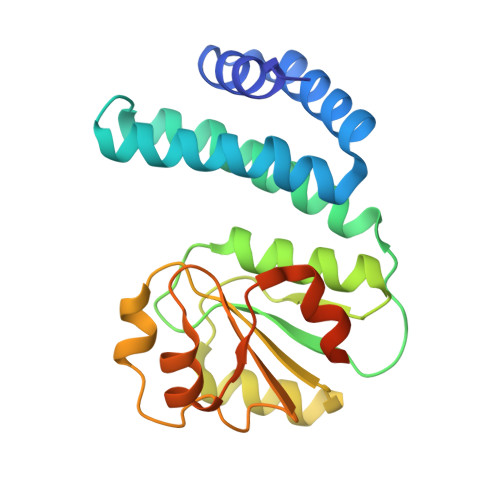Redox driven B 12 -ligand switch drives CarH photoresponse.
Poddar, H., Rios-Santacruz, R., Heyes, D.J., Shanmugam, M., Brookfield, A., Johannissen, L.O., Levy, C.W., Jeffreys, L.N., Zhang, S., Sakuma, M., Colletier, J.P., Hay, S., Schiro, G., Weik, M., Scrutton, N.S., Leys, D.(2023) Nat Commun 14: 5082-5082
- PubMed: 37604813
- DOI: https://doi.org/10.1038/s41467-023-40817-6
- Primary Citation of Related Structures:
8C31, 8C32, 8C33, 8C34, 8C35, 8C36, 8C37, 8C73, 8C76 - PubMed Abstract:
CarH is a coenzyme B 12 -dependent photoreceptor involved in regulating carotenoid biosynthesis. How light-triggered cleavage of the B 12 Co-C bond culminates in CarH tetramer dissociation to initiate transcription remains unclear. Here, a series of crystal structures of the CarH B 12 -binding domain after illumination suggest formation of unforeseen intermediate states prior to tetramer dissociation. Unexpectedly, in the absence of oxygen, Co-C bond cleavage is followed by reorientation of the corrin ring and a switch from a lower to upper histidine-Co ligation, corresponding to a pentacoordinate state. Under aerobic conditions, rapid flash-cooling of crystals prior to deterioration upon illumination confirm a similar B 12 -ligand switch occurs. Removal of the upper His-ligating residue prevents monomer formation upon illumination. Combined with detailed solution spectroscopy and computational studies, these data demonstrate the CarH photoresponse integrates B 12 photo- and redox-chemistry to drive large-scale conformational changes through stepwise Co-ligation changes.
Organizational Affiliation:
Manchester Institute of Biotechnology, Department of Chemistry, University of Manchester, Manchester, UK.















